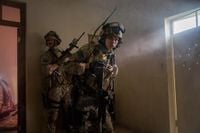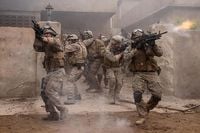In a striking exploration of the subjective nature of war, the film Warfare, co-directed by former Navy SEAL Ray Mendoza and acclaimed filmmaker Alex Garland, delves into the harrowing experiences of a military operation in Iraq. Set in 2006, the film is based on Mendoza's own recollections of an encounter his Navy SEAL platoon, Alpha One, had during the tumultuous aftermath of the Battle of Ramadi.
The movie opens with a title card that reads, "Based on Memories," establishing its autobiographical intent. As the story unfolds, viewers are thrust into the chaotic atmosphere of a military mission that lacks the traditional narrative structure of most war films. Instead of focusing on character development or overarching themes, Warfare immerses its audience in the visceral reality of combat, where the humanity of both soldiers and civilians is starkly portrayed.
In a departure from the genre's usual tropes, the film presents a raw depiction of warfare that emphasizes the emotional weight of its characters, who are often unnamed and devoid of backstories. This stylistic choice reflects the chaotic and impersonal nature of war itself. The film features a cast that includes D'Pharaoh Woon-A-Tai as Ray Mendoza, Will Poulter as Officer in Charge Erik, and Cosmo Jarvis as sniper Elliott Miller, who suffers severe injuries during the mission.
As the plot progresses, the SEALs take control of a multi-story house in Ramadi, where two families are confined to a single room, highlighting the human cost of military operations. The film's sound design plays a crucial role in conveying the intensity of the experience. Unlike many traditional war films that rely on musical scores to evoke emotion, Warfare opts for a stark absence of music, allowing the sounds of battle to dominate the auditory landscape. Gunfire, explosions, and the haunting wails of injured soldiers fill the air, creating an overwhelming atmosphere that lingers long after the visuals have faded.
One particularly harrowing moment occurs when an American soldier, portrayed by Joseph Quinn, is left wailing after sustaining life-altering injuries from an explosion. This sound, rather than the graphic visuals, becomes the lasting impression for viewers, as it encapsulates the horror and chaos of the battlefield. Mendoza and Garland's attention to detail in sound design serves to amplify the emotional impact of the film, drawing audiences deeper into the experience.
The film's pacing mirrors the reality of combat, oscillating between tense, quiet moments and sudden bursts of violence. This structure reflects the unpredictability of war, where soldiers often find themselves waiting for action, only to wish for the calm once the chaos begins. Critics have noted that this approach may challenge viewers accustomed to more conventional storytelling, as Warfare resists clear character arcs or moral conclusions.
"The film presents itself for what it is, a recreation of memory, most of which is truly disturbing and hard to watch," one critic noted. This sentiment captures the essence of Mendoza's vision: to portray warfare not as a glorified spectacle, but as a grim reality filled with uncertainty and fear.
Despite its unflinching portrayal of violence, Warfare does not overtly advocate for or against war. Instead, it presents a nuanced view that allows audiences to grapple with the complexities of conflict. The film's dedication to the memory of Elliott Miller, who was severely wounded and retains no recollection of the day, further underscores its commitment to honoring the experiences of those who have served.
While some critics have likened Warfare to iconic war films like Saving Private Ryan, others argue that it carves out its own identity by focusing on the subjective nature of memory and experience. As Tim O’Brien famously wrote in his collection The Things They Carried, “In any war story, but especially a true one, it’s difficult to separate what happened from what seemed to happen.” This sentiment resonates throughout Warfare, as it seeks to convey the emotional truth of Mendoza's experiences rather than a straightforward account of events.
Ultimately, Warfare stands as a poignant reminder of the human cost of conflict. It challenges viewers to confront the uncomfortable realities of war, moving beyond the glorified narratives often depicted in mainstream cinema. By focusing on the lived experiences of soldiers and civilians alike, Mendoza and Garland invite audiences to reflect on the complexities of warfare and its lasting impact on individuals and communities.
As the film concludes, viewers are left with lingering questions about the purpose of the mission and the suffering it caused. When an Iraqi mother cries out, "Why?" during the invasion of her home, the soldiers have no answer, nor does the film provide one. Instead, Warfare emphasizes the ambiguity of war, leaving audiences to grapple with the moral complexities that often accompany military actions.
In a world where war often feels distant and abstract, Warfare serves as a powerful reminder of the human stories that lie at the heart of conflict. It challenges us to listen to those stories, to acknowledge the pain and suffering that accompany war, and to reflect on the choices that lead to such devastating consequences.








